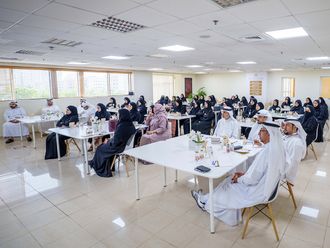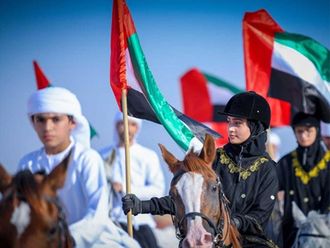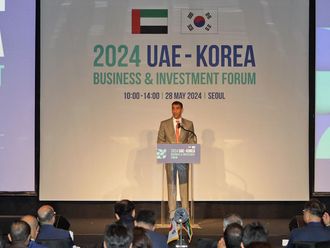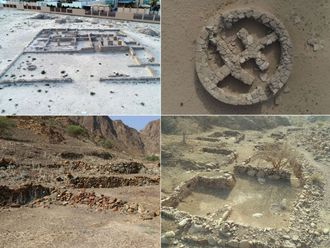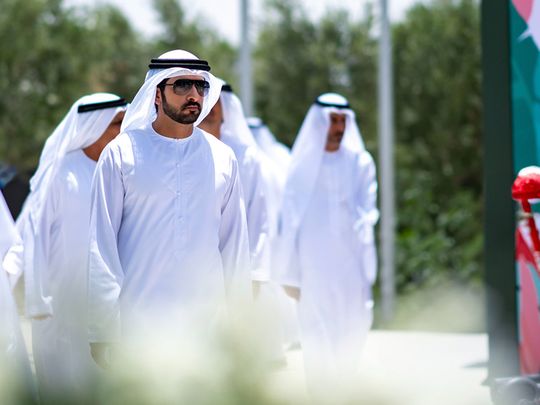
Dubai: A new strategy encompassing 200 projects that aim to turn Dubai into one of the world’s best city to live in was unveiled on Tuesday.
Under the directives of His Highness Sheikh Mohammed bin Rashid Al Maktoum, Vice President and Prime Minister of the UAE and Ruler of Dubai, the Dubai Quality of Life Strategy 2033 was approved by Sheikh Hamdan bin Mohammed bin Rashid Al Maktoum, Crown Prince of Dubai and Chairman of Dubai Executive Council.
Sheikh Hamdan bin Mohammed stressed that caring for people remains the cornerstone of Dubai’s sustainable development strategies. The wellbeing of individuals is the ultimate objective of development plans and the primary criterion for the success of government programmes, he said.
“We have today [Tuesday] approved the Dubai Quality of Life Strategy 2033 as part of our efforts to raise our global standing in the economy as well as in the areas of innovation and wellbeing. The vibrancy and cultural diversity of our society are key to our development journey,” Sheikh Hamdan added.
“The Dubai Quality of Life Strategy encompasses over 200 projects, initiatives, and plans. The strategy encompasses 10 key pillars, all dedicated to fostering the wellbeing of individuals, society, and the city. Our objective is to establish Dubai as one of the world’s best cities in terms of wellbeing, offer every resident a healthy, active, and enjoyable lifestyle, build a society that takes pride in its identity and cultural diversity, and offer the highest quality of leisure and entertainment. Dubai’s name will become synonymous with fine living worldwide.”
He further stated: “All projects initiated as part of the strategy will be overseen by a new office dedicated to enhancing quality of life in Dubai, in coordination with over 19 government entities and dozens of private organisations.”
Sheikh Hamdan made these remarks after reviewing the highlights of the Dubai Quality of Life Strategy, which is aligned with the Dubai 2040 Urban Master Plan. The strategy features an integrated roadmap for sustainable urban development in the city for all segments of the community aimed at realising Sheikh Mohammed’s vision for Dubai’s future and establishing it as one of the world’s best cities in terms of wellbeing.
Launch event
Upon arrival at the designated location for the plan’s launch at Keturah Reserve, Sheikh Hamdan was received by Mattar Al Tayer, Commissioner-General for Infrastructure, Urban Planning and Well-Being Pillar. Sheikh Hamdan was briefed about a host of innovative initiatives that included wellbeing districts, the 20-minute city concept, development of a new generation of parks, the walking strategy, development plans for outlying areas, the development of beaches, the landscaping strategy, and the development of sports and entertainment facilities accessible to all.
Model neighbourhoods
Sheikh Hamdan reviewed the new vision for designing model neighbourhoods covering three districts across Dubai: Al Mizhar 1, Al Khawaneej 2, and Al Barsha 2. This new vision aims to enhance the infrastructure of these existing neighbourhoods by upgrading social amenities and services, promoting soft mobility options for healthier living environments, and improving connections between community hubs such as parks, mosques, and shops.
More than 115km of pedestrian and cycling tracks will be constructed, more than 3,000 trees and plants will be planted, and more than 20 investment opportunities will be created during Phase 1 of the strategy for the residents of Al Khawaneej 2 and Al Barsha 2.
The redevelopment plans include upgrading the existing collector streets and constructing shaded canopies, lanes for bikes and e-scooters, pedestrian walkways, restrooms, and family recreational spaces.
'20-minute city'
The vision also involves landscaping, constructing distinctive architectural gateways for each residential community, giving a unique character to every neighbourhood, and improving alleyways and street intersections to boost safety and provide pedestrian lanes.
Furthermore, it offers investment opportunities for locals, enhances public services, and delivers the ‘20-minute city’ concept, which aims to ensure residents can access 80 per cent of essential services within a 20-minute journey aboard soft and sustainable mobility options.
Sheikh Hamdan also reviewed the designs of the next generation of parks in Dubai, featuring new and innovative design elements that cater to the diverse needs of the community, reflect the unique character of each district, and incorporate sustainable activities to foster wellbeing. More than 30 parks with the new designs will be developed across the emirate within three years.
Sheikh Hamdan directed all government departments in Dubai to expedite the implementation of projects and initiatives linked to the Dubai Quality of Life Strategy.
Implementation in phases
Encompassing over 200 projects, initiatives, and supporting plans, the Dubai Quality of Life Strategy is set for implementation in three phases from 2024 to 2033. It covers 10 key pillars pertinent to wellbeing: culture and entertainment, the natural environment, the urban environment, mobility, society and family, the economic environment, employment and work conditions, education, safety and security, and health. The new strategy targets the individual, society, and the city, placing humans as a top priority.
The strategy targets all community segments, including nationals, residents, and international visitors to Dubai. Additionally, it focuses on seven key demographic categories: women, seniors, nationals, people of determination, children, youth, and white-collar workers.
Over 19 entities in Dubai have collaborated to develop an integrated plan for all the main initiatives and aspects of the Quality of Life Strategy and a roadmap for implementing pioneering programmes targeted at the individual, society, and the city. Working together, they identified the current status of each axis and the targets set until 2033.
The private sector will play an active role in executing the initiatives and projects of the Dubai Quality of Life Strategy, as part of the influential role it plays in supporting the emirate’s comprehensive economic development. Through its efforts, the sector will seek to accelerate the achievement of ambitious goals included in the Dubai Economic Agenda D33.
The strategy includes 100 projects and initiatives that can be implemented in partnership with the private sector, ensuring its strong presence and clear impact through high-value, qualitative projects that contribute to the wellbeing of Dubai’s community.
Overall aim
The Dubai Quality of Life Strategy is committed to providing a distinctive wellbeing experience for the community, guided by three primary objectives. The first goal is to foster wellbeing at an individual level. It involves development plans that prioritise people’s wellbeing, stability, and happiness.
This goal focuses on elevating individual quality of life and improving the quality of physical wellbeing. This will be achieved through two key aspects. The first focuses on mental and physical health and, the economic environment, while the second addresses social and psychological wellbeing, encompassing three components: education, employment and work conditions, and security and safety.
It seeks to foster a harmonious balance between an individual’s health, happiness, wellbeing, and productive capacity to enable Dubai’s inhabitants to lead healthy, active, and fulfilling lives. The strategy seeks to achieve this objective by empowering community members to embrace a lifestyle rooted in health, happiness, positivity, creativity, adaptability, and social intelligence, which in turn contributes to enhancing the quality of their relationships and social life. This will make critical contributions to realising the vision of Sheikh Mohammed to establish Dubai as the world’s best city to live in.
Second goal
The second key goal of the Dubai Quality of Life Strategy is centred around the community. It aims to enhance individual lives within the broader community context, focusing on emotional wellbeing and fostering a cohesive community that takes pride in its identity, preserves its cultural heritage and Emirati values, and celebrates its association with the achievements of Dubai. The strategy is designed to cultivate an integrated environment that embraces all community segments and safeguards the community’s culture, heritage, and traditions while bolstering social cohesion.
The strategy also seeks to enhance cultural diversity within Dubai society. The UAE and Dubai are home to over 200 nationalities, all enjoying a high quality of living marked by respect and equality. This multiculturalism has transformed Dubai into a haven for cultural diversity and civilisational harmony, and a beacon for tolerance and coexistence.
The strategy also seeks to offer diverse entertainment options that enhance the happiness of all members, including nationals, residents, and international visitors of all ages, cultures, and interests.
Third goal
The third key goal of the Dubai Quality of Life Strategy is to elevate wellbeing at the city level. This goal is centred on providing a unique urban experience for nationals, residents, and visitors centred on human needs. The strategy envisions a city with accessible beaches, expansive open spaces, recreational squares and parks, fostering a healthy environment for both residents and visitors. The third goal also makes vital contributions to realising the goal of Sheikh Mohammed to make Dubai an eco- and pedestrian-friendly city, and a city with a high urban agriculture yield.
Natural environment
By enhancing its natural environment, the Dubai Quality of Life Strategy seeks to foster lifestyles and practices that prioritise the conservation of the environment and natural resources, ensuring their sustainability for present and future generations.
This aspect includes a series of projects and initiatives aimed at enhancing wellbeing while maintaining environmental sustainability. Key components include 376 stations and sites dedicated to monitoring aquatic environments and air pollutants, and the world’s largest waste-to-energy conversion project, whose first phase has already been completed. The strategy seeks to provide eight natural wildlife reserves spanning an area of 1,266 square kilometres, and marine reserves covering 32 square kilometres.
The strategy also aims to preserve Dubai’s rich biological diversity. The emirate is home to 1,524 species of living organisms, including 342 species of birds, 46 species of mammals, 51 species of reptiles, 315 species of plants, 188 species of fish, and 582 species of invertebrates.
The Dubai Quality of Life Strategy seeks to consolidate Dubai’s top-ranking position in per capita access to electricity. Dubai’s global leadership in this area has massively contributed to the high satisfaction ratings of residents regarding the quality of water and electricity services, as indicated in wellbeing surveys.
The strategy has set several targets in the field of energy in the run up to 2033. Key initiatives include expanding electricity charging stations across Dubai and developing the Mohammed bin Rashid Solar Park, the world’s largest single-site solar energy park.
Integrated development
The Dubai Quality of Life Strategy incorporates a comprehensive plan to improve Dubai’s beachfront areas. This plan entails various development projects including upgrading Jebel Ali Beach, Jebel Ali Caravans Camp Beach, as well as Jumeirah, Umm Suqeim, and Al Mamzar Beaches.
Key targets include a 300 per cent increase in public services provision by 2025, ensuring 100 per cent accessibility for people of determination and senior citizens, expanding cycling tracks on beaches by 300 per cent, extending the length of night swimming beaches by 60 per cent, and designating new beaches exclusively for women. These initiatives are aligned with the objectives of the Dubai 2040 Urban Master Plan, which aims to increase the length of public beaches by 400 per cent.
Tourism appeal
The strategy aims to enhance the tourism appeal of areas like Hatta, Lehbab, Al Marmoom, Al Lisaili, Al Faqa’, Nizwa, Al Awir, and Margham . It involves several initiatives to improve wellbeing, create investment opportunities for families, support farmers and local products, and conserve natural reserves and archaeological sites.
The strategy’s initiatives include a 162 per cent increase in services like health, schools, parks, and mosques. The strategy also entails meeting the housing needs of nationals in outlying areas, development of the Saih Al Salam Path with events and investment opportunities, and several enhancements in Hatta such as hiking, hospital and educational facility upgrades, and housing projects for nationals.
Expanding greenery
The Dubai Quality of Life Strategy sets ambitious targets to expand the emirate’s green cover. The strategy recognises that green spaces, apart from having aesthetic value, have considerable environmental significance, since they play a key role in reducing carbon emissions, improving air quality, and lowering temperatures.
The strategy seeks to increase the planting of trees and flowers in the streets, public roads, squares and parks, in line with Dubai’s sustainability standards, as well as implement sustainable irrigation projects.
Greenery is one of the main elements supporting the strategy, with a portfolio of projects aimed at increasing the total green area in the emirate through the implementation of several major initiatives by 2033. This includes expanding the area of public parks from 23 to 64 square kilometres (a 180 per cent increase) and developing over 200 parks and squares in different areas across the emirate.
Quantum leap
The Dubai Quality of Life Strategy seeks to transform mobility in Dubai by developing innovative solutions and an integrated inclusive infrastructure that adopts the latest developments in transportation infrastructure. It also aims to reduce the use of private vehicles, encourage public transportation, reduce carbon footprint, enhance access to attractions, and improve road safety, ultimately positioning Dubai among the world’s top 10 cities for ease of mobility.
Further, the strategy aims to achieve a quantum shift in employing artificial intelligence in harnessing self-driving mobility to serve humans, thus establishing a unique global model for future cities.
By 2033, the strategy aims to convert 25 per cent of all trips in the city to self-driving travel and achieve 45 per cent transportation through sustainable means, while also transforming Dubai into a pedestrian-friendly city.
It aims to double the length of cycling lanes from 544km to 1,150km, increase bus routes by 117 per cent from 4,008 to 8,722km, and expand the railway network from 100 to 159km.
The strategy aims to consolidate the shift in Dubai’s mobility landscape. In 2023, public and shared transportation accounted for 21 per cent of total trips, with the metro achieving 99.7 per cent punctuality (ranked fifth globally). Cycling lanes totalled 544km, and sustainable mobility accounted for around 35 per cent of total trips. Dubai has become a leading global city in road quality, with a high population satisfaction rating in the quality and cleanliness of public transportation.
Diversity in community
The strategy includes more than 1,000 annual sports, community, cultural, arts, and entertainment events. Areas allocated to entertainment, tourism, and hotels are planned to be increased by 134 per cent by 2040, ensuring that Dubai is transformed into a meeting point for diverse cultures, and a place where every individual can celebrate their identity and enjoy various activities that meet their aspirations.
Investing in capabilities
The Dubai Quality of Life Strategy places youth and children at the forefront of its priorities, with the aim of empowering them to serve their nation.
The strategy focuses on investing in the development of the skills and capabilities of younger generations and enhancing their contribution to Dubai’s sustainable development journey. This reflects Sheikh Mohammed’s belief that governments cannot advance development without engaging the youth, as they are critical to a nation’s resurgence and the creators of its future.
The strategy includes several initiatives for children and youth, including promoting mental health, raising newborn screening standards, active schools, youth counselling and guidance, the Children’s Internet Safety Programme, and the Children’s STEM Museum.



